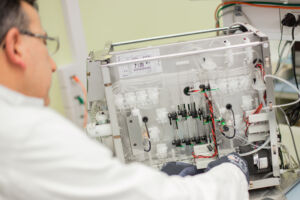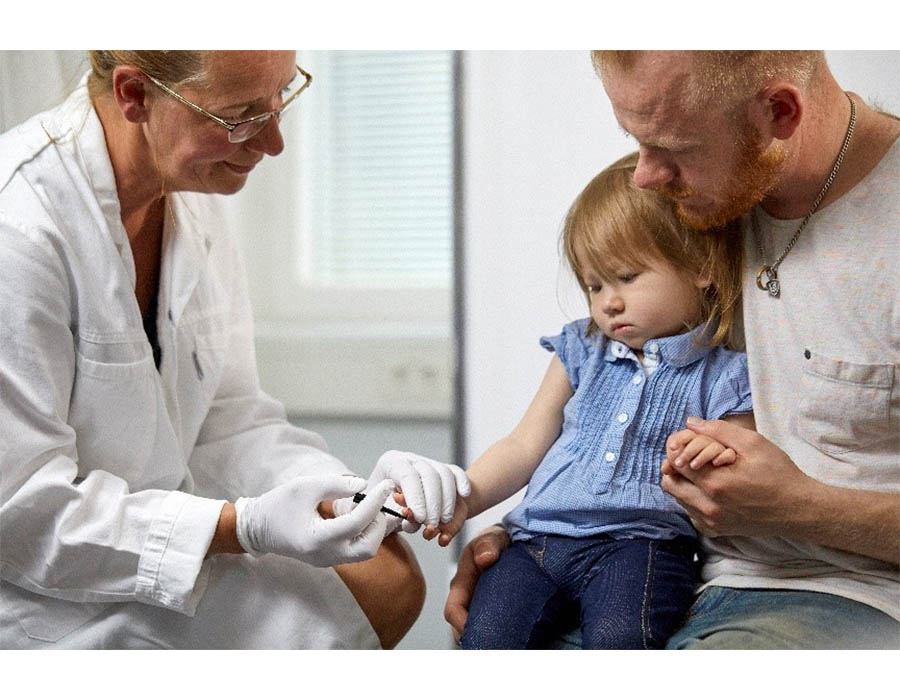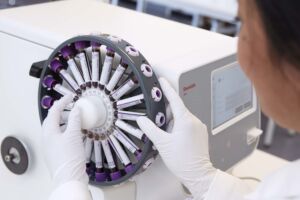Hematology testing in a future perspective
Clinical diagnostics is a cornerstone in healthcare and the results form the basis for medical decision-making. Hematology analysis is widely requested, both as an initial test in patient assessments as well as in monitoring of disease progression and treatment efficacy. Although the first automated hematology analyzers were launched already in the 1950s, the method is still widely adopted in diagnostic laboratories worldwide. A hematology analysis is cheaper relative to many more specific tests, and therefore accessible, and the results provide insights for many disease conditions that affect the blood cells, such as certain infections, anemia, blood clotting problems, and blood cancers.

Hematology market trends
The growing demand for hematology testing can, to large part, be attributed to the aging population, requiring a greater number of tests, and the increasing investments in healthcare in emerging markets (1). Traditionally, hematology testing is conducted at a clinical laboratory away from the patient. However, today’s technology advancements have enabled equipment manufacturers to provide small devises that produce laboratory-quality analysis results that can be automatically transferred to the laboratory information system (LIS). Such equipment facilitates health assessments in the primary care, shortening time to diagnosis and initiation of treatment. Pre-analytic risk factors such as blood coagulation can also be minimized when time between sampling and analysis is shortened.
Decentralized testing devices have thus significantly contributed to the overall growth of the hematology market, which is expected to reach 821 MUSD by 2024 (1). In laboratory hematology testing, complete blood count (CBC) tests account for about 40% of total revenues, compared with hemoglobin at 20% and other tests (e.g., hemostasis and coagulation) combined at the remaining 40%. Improved cost-efficiency of benchtop analyzers is among the factors that have been driving this development, which is seen further accelerated by the COVID-19 pandemic (2).
Another practice that has gained increased popularity during the COVID-19 pandemic is telemedicine, with the opportunity to provide patients access to medical experts at a lower cost (3). However, telemedicine does not allow diagnostic testing. Patients monitored for disease recovery or adjustment of medication dosage for chronic diseases would greatly benefit from having access to nearby testing services to prevent prolonging the time to a new diagnosis.

Benefits of on-site hematology testing
An incentive for centralization of diagnostic testing is the possibility to improve testing efficiency, while lowering the cost per test. However, there are situations where near-patient testing can be of greater benefit to the patient. Not only is on-site testing convenient for the patient, omitting the need to travel a longer distance to a site for blood sampling and testing. On-site testing can also be crucial for reducing turnaround time in case quick response is required to meet urgent clinical needs.
Results from a low-cost hematology analysis can be used in initial disease investigations to support evaluation of the need for more expensive tests or for sending samples away for further testing at a central laboratory. Near-patient hematology testing is also often used when close monitoring of patient recovery is required, for example, in progression of an infectious disease affecting the blood cells, prior to chemotherapy, or in assessment of regular blood donors.

Requirements on an on-site testing device
Technologies enabling tomorrow’s hematology testing
Another factor that drives growth of the hematology testing market is the enhanced capabilities of the analyzers, such as expanded range of reported parameters and functionality to test other body fluids than whole blood.
Since the very first automated hematology analyzers were launched in the 1950s, the majority of all blood cell counts is still based on electrical impedance technology. In the 1980s, this technology was supplemented with optical flow cytometry to allow differentiation of the white blood cells (WBCs) into their five sub-groups (neutrophils, lymphocytes, monocytes, eosinophils, and basophils) in an automated manner.
One could argue that little has happened on the technology side over the years, but the development of the automated cell counters has focused on aspects such as sample aspiration and dilution, cell count method and principle, and cell discrimination method to improve the measurement quality of available devices.
Although early trials were made to use image analysis for the WBC differential count, these analyzers were expensive and thus not widely adopted in routine clinical use (4). Today, cost-efficient analyzers that use optical microscopy and AI-based digital imagingto automate the microscopic examination of blood smears are available to investigate the presence of pathological cell morphologies that can be difficult for an automated hematology analyzer to distinguish from normal cells.
Connectivity is key for data transfer between the site for diagnostic testing at the point of care and site for decision making by centralized medical expertise. With healthcare organizations constructing data-management infrastructure, decentralized diagnostic testing has become an attractive alternative to traditional laboratory testing at a central testing service facility.
“Since we decided to partner with Boule for the distribution of Medonic systems in our country a little over five years ago, we have managed to capture an important portion of the market, especially in the north, where practically all the regional health centers (primary care) are equipped with our instruments”, says Yodely Tavares, Managing Director at Cruz Ayala, Dominican Republic. “Cruz Ayala, together with Boule Diagnostics, is recognized in Dominican Republic for offering the best value for money.”
“Once our clients manage to overcome the initial doubt of instrument quality and reliability in the results, they usually double their number of daily samples”, Maximo Cruz Ayala, CEO Cruz Ayala continues. “Also, the complexity of the patients who come for their services increase. Consequently, they will look for analyzers that allow them to handle these new conditions (sample volume and complexity) in an efficient way. We therefore foresee and increased interest in 5-part instruments with autoloader in the upcoming three to five years. As many testing services compete for business, they are also looking to add reticulocyte count as a competitive advantage of their laboratory.”
“The possibility of remote communication with lab instrumentation is today a widespread idea that many manufacturers are trying to turn into reality”, says Maximo. “The ability for our service engineers to remotely diagnose possible instrument issues can take us to the next level in terms of after sales support. Knowing the cause of the problem, correcting it remotely and, where appropriate, visiting our clients and bring the correct necessary spare part is the immediate future.”

Our vision for the future
Boule products and solutions have supported hematology analysis in small-to mid-sized hospital and clinical laboratories since the very beginning in the 1950s. Featuring a robust design, space-saving solutions, and the ability to report a complete blood count, including a differential count of the white blood cells, from a finger stick sample in one minute, the analyzers are purpose built to meet the special needs of the decentralized hematology testing market.
Blood status determination by analysis of the blood cell count is maintaining its relevance with novel indications of established parameters. For example, the lymphocyte count has proven to provide insight into COVID-19 disease severity.
Emerging technologies, enabling enhanced clinical insights, will provide new juvenility to hematology analysis. With expanded parameter ranges, AI, and cloud-based solutions for remote access to instrument data, hematology system solutions will provide reports at an ever-increasing speed, reliability, and precision to support clinicians in decision making for many years to come.
“We are committed to provide versatile, high-quality, near-patient diagnostics solutions for everyone everywhere”, says Jesper Söderqvist, CEO of Boule Diagnostics. “Boule is well-positioned to leverage emerging technologies and innovate to build an even stronger product portfolio and service offering in the years to come. By working closely with all our partners around the globe, we will ensure that our offerings are tailored to specific market needs – also in the future.”

Learn more
Read about the history of Boule diagnostics, bringing hematology testing to the point of care
References
- Report: Hematology and Coagulation Markets, Kalorama, May 2020
- Agarwal et al. How SARS-CoV-2 Will Catalyze Decentralized Testing. www.healthadvancesblog.com Apr 2020 (accessed 27 Feb 2021).
- Whelan, C. 17 benefits of telemedicine for doctors and patients. www.healthline.com Nov 9 2020 (accessed 27 Dec 2020).
- Hagve, T-A. Fra mikroskop til flowcelle. Klinisk Biokemi i Norden 2, 8–17 (2007).

